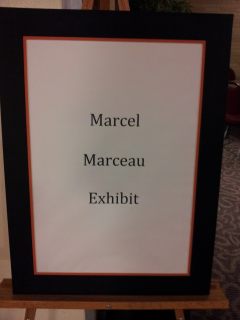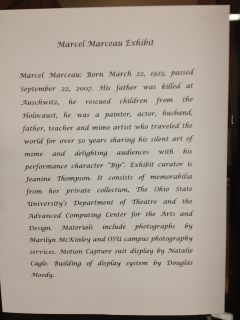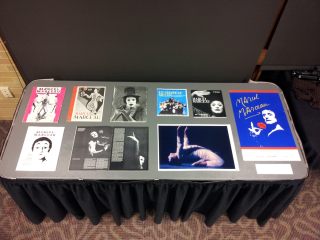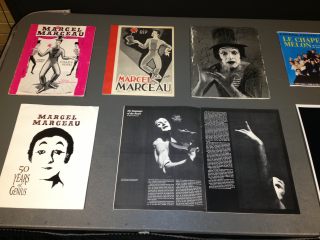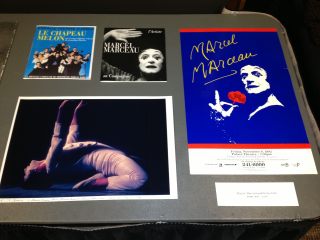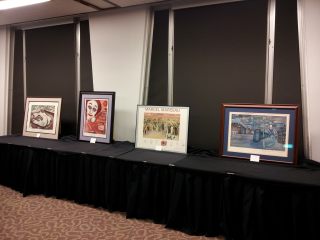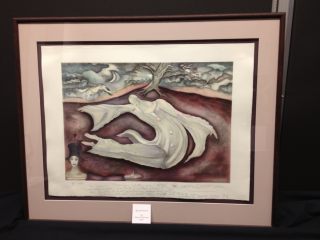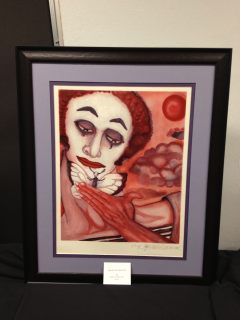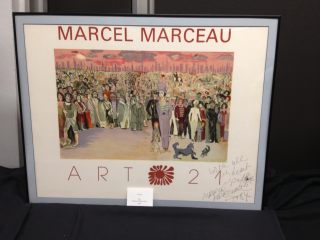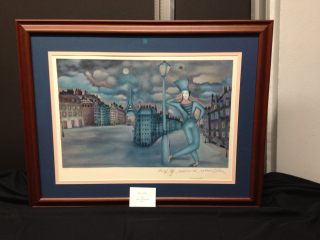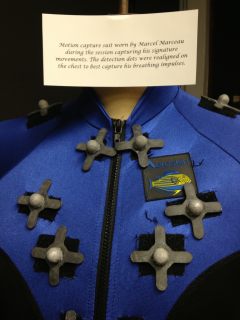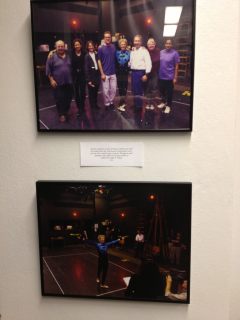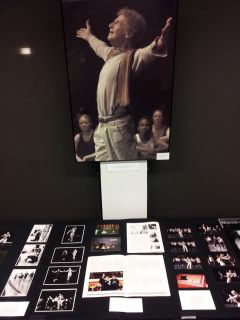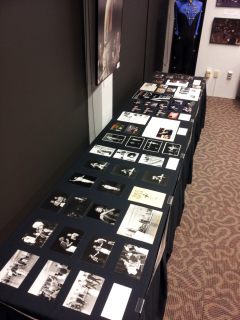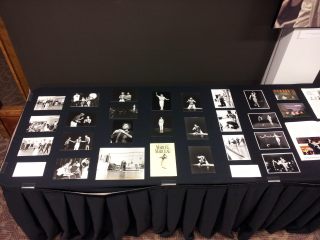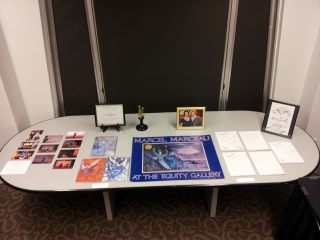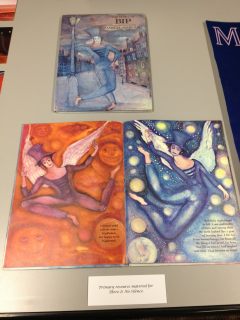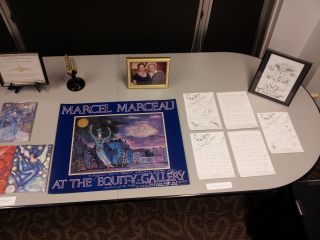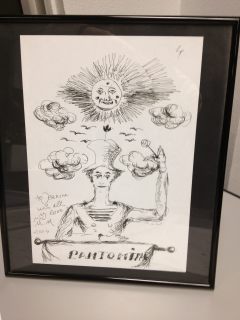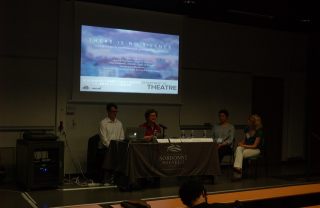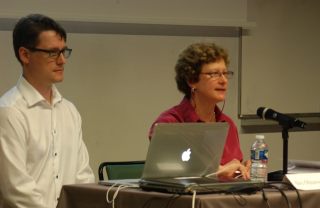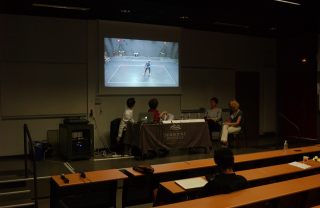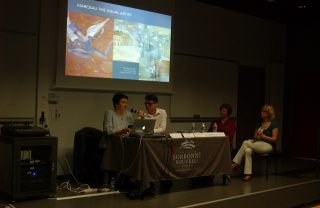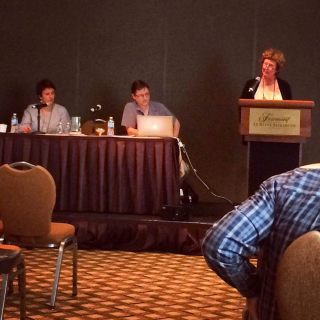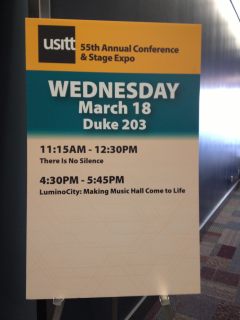This was a major research project that I led that started preparing for in 2012 and culminated in a new works creation and performance of There Is No Silence in 2014. My primary collaborators were Vita Berezina-Blackburn, animation specialist at OSU’s Advanced Computing Center for the Arts and Design (ACCAD), and Alex Oliszewski, multimedia systems specialist in Theatre and ACCAD. We are continuing our work started on this project by disseminating our research findings and sharing the new work created, through writing, presentations and curriculum development.
The Marcel Marceau Project was generously supported by the OSU Department of Theatre and the Advanced Computing Center for the Arts and Design. It was truly a partnership and collaboration. Additional grant support that I received included OSU Arts and Sciences Research Enhancement, Coca-Cola Critical Difference for Women, Arts & Humanities Associate Professor Mentoring Program, and the Bertha Klausner Fellowship Award.
The Marcel Marceau Project had the following seven branches of research.
| | Students learning mime with Marcel Marceau’s Motion Capture |
| |
| | |
I teach Mime technique as part of the curriculum at OSU. In preparing the students who were going to be devising the performance, I focused a portion of my mime class on having the students learn Marcel Marceau’s adagio “At The Bar” by watching ACCAD’s motion capture and video of him doing it. The students were then motion captured doing the adagio at ACCAD led by Vita. This culminated with the students analyzing the distinctions in the nuances of gesture and timing of their work and Marceau’s work, by comparing and contrasting their motion capture alongside Marceau’s motion capture.
|
| |
| | Creating new work with technology |
| |
| | |
When I first thought of doing this research project and creating a devised work about Marcel Marceau with my students, I knew three things that related to the use of technology: 1) somehow I wanted to utilize the Marceau motion capture data in teaching the mime class, 2) somehow I wanted the show to include a virtual duet with Marceau’s motion capture and one of my students, and 3) I wanted to do this project as a collaboration with Vita, who I had worked with before in The Camouflage Project. During my initial planning meetings with Vita, we both decided that we would explore the working with the technology and devise the show in a way that would help the actors, technicians and animators to collaborate and create the work together. With this as our guiding principle, all that we did, we did together, one informing the other.
Early on we determined the technology that we would explore creating the new work with. That included motion capture, projected animation and silhouettes. We began first by training our actors in motion capture, and then we explored the actors interacting with their projected live motion capture with live animation. This process started valuable dialogues between the actors, animators and technicians. During the mime class when the students were analyzing their motion capture movements with Marceau’s, they could actually see the distinction in their nuances of gesture and timing, and they learned the quality and value of their own work that is so clearly revealed in the motion capture data. This got them very interested in utilizing motion capture in the performance. This started Vita, Alex and I thinking about how we might actually build a motion capture studio on the theatre stage. We knew immediately that this decision might impact the work of our lighting designer, so we started our conversations with him about this challenge and opportunity. We explored manipulating puppet that were motion captured and facial capturing. One element that we especially enjoyed the childlike aspect of was working with silhouette. In the fall before our spring production, we brought all of our research elements together in a script that I wrote called The Story of Bip. This allowed us an invaluable opportunity to try to make our research performative and shared the seed of the idea of the final idea for the script with our entire production team. An idea that came out of this was from our scenic designer who envisioned a proscenium sized curtain, consisting of three curtains, that could be automated to move in multiple ways: the traditional opening and closing from side to side, moving up and down, and then being able to open and close all together thus allowing for revealing and disappearing of characters and props to happen anywhere on the stage.
All of these avenues of research added up to creating a magical production, but what enabled us to achieve that was starting by having conversations with the actors and entire production team from the very beginning of the process and developing the performance work along with the technology - thus creating an integrated production.
You can read more about both of these processes in the article Vita Berezina-Blackburn, Alex Oliszewski and I wrote called Technology for Mime Training and Devising of “There Is No Silence” published in the Theatre, Dance Performance Training Blog 1/2016.
|
| |
| | Creating new work with archival primary resource material |
| |
| | |
Throughout this process, the students, designers and I researched the archival materials held in the OSU Theatre Research Institute’s (TRI) Marcel Marceau American Archive and ACCAD’s Motion Capture Data Bank of Marcel Marceau’s Motion Capture Data. We viewed videotapes, read articles and books, and looked at the abundance of international touring materials.
In 2013, I was granted the Bertha Klausner Fellowship to research her archive that has a section on Marceau. She was Marceau’s literary agent. This archive is held at the American Heritage Center (AHC) located at the University of Wyoming in Laramie, WY. I visited AHC twice and researched the bounty of information in this archive. I presented a lecture/demonstration of my findings at the AHC in the fall of 2014.
The entire production team and students also utilized the archival materials I found in the Klausner archive in our research and devising process. This included letters sent between Marceau, Klausner and many publishers; photos; book illustrations by Marceau; and some photos of life size dolls of Marceau that someone made. These dolls directly inspired our exploration of developing potential scene material by manipulating a huge puppet that was being motion captured.
You can read more about my findings in the Klausner archive and how we utilized archival material, in the lecture that gave at the American Heritage Center titled From Storage to the Stage: Using Archives to Research, Create and Perform.
|
| |
| | Production of There Is No Silence |
| |
| | |
There Is No Silence is a two-hour interdisciplinary multimedia play about the life and work of the great French mime artist, Marcel Marceau. It was collaboratively created through a year and half-long devising process by faculty, MFA actors and production design team. It was performed by the MFA actors. The storyline includes four actors portraying Marcel Marceau at different stages of his life, Marceau’s performance persona Bip, Marceau’s wife Anne Sicco, his daughter Aurelia, and a hobo mime who narrates the show. The innovative technology used was integrated throughout the production. It included a projection system that wrangled live performance animation, prerecorded 3-dementional animation, video and live silhouette shadow performance. The physical setup on the stage was comprised of six movable projection surfaces, a motion capture area integrated into the main performance space, lighting with traditional and LED lights that facilitated live silhouette integration and animation projections, and full proscenium sized automated curtains that allowed for dynamic framing of live and projected action. We came to consider this work a type of augmented reality: real, live events, being augmented, changed, with virtual environments responding in real time.
You can read more about There Is No Silence on this website under Theatre, New Works Creation.
|
| |
| | Exhibit of Marcel Marceau’s Lithographs and Memorabilia |
| |
| | |
This exhibit coincided with the production of There Is No Silence and was held in the Drake Performance Center. I wanted to provide the audience, symposium participants and those involved with the production, an opportunity to see some of Marcel Marceau’s memorabilia. I curated this exhibit that included many of Marceau’s touring programs; photos from the three residencies he did at OSU, including him receiving an Honorary Doctorate in 1999; his motion capture suit; and several lithographs of his paintings. He was an excellent painter with a style very similar to Marc Chagall and his visual artistry inspired the animated environment for this production.
Photography by: Douglas Moody
|
| |
| | Making the Invisible Visible: Mime’s Contemporary Legacy Symposium |
| |
| | |
This symposium was coordinated by Shilarna Stokes, Francesca Spedalieri and I, and it coincided with the production of There Is No Silence. Numerous internationally known mime and movement theatre artists presented including Daniel Stein, international touring artist and former School Director of The Dell’Arte International School of Physical Theatre, Rob Mermin, founder of Circus Smirkus, John Giffin, choreographer and former dancer with the Pina Bausch company, and Lorin Eric Salm, professional mime and actor working in the film industry and motion capture. Our Keynote speaker was Annette Thornton, mime artist and President of the Association of Theatre Movement Educators.
One of the highlights of the symposium for me was what Daniel Stein, who I had never met before this event, said at the opening of his session: “Jeanine, I applaud you for having the courage to put up a piece of mime theatre and inviting a group of bastard mimes to come in to critique it. I applaud you for putting your work on the line and walking the talk. Bravo!”
You can read more about the mime symposium and those who presented in the article I wrote Making the Invisible Visible: Mime’s Contemporary Legacy A Mime and Movement Theatre Symposium that was published in the ATME News Publication Fall 2014.
|
| |
| | Sharing research at international conferences |
| |
| | |
My project collaborators, Vita and Alex and I, shared our research presentations of Devising and Movement Training with Performance Capture and Animation and There Is No Silence: Remembering the artist and WW II hero, Marcel Marceau, in a devised work with integrated technology including live motion capture and animation at the following conferences in 2015: the International Federation for Theatre Research Bodies on Stage: Acting Confronted by Technology, Paris, France, the Association for Theatre in Higher Education Je me souviens / I remember, Montreal, Canada, the United States Institute for Theatre Technology, Cincinnati, Ohio, and ACCAD’s Open House, Columbus, Ohio.
“The work presented, There Is No Silence, is not only beautiful, but of enormous importance to the areas of performance, digital performance, and theatre pedagogy. Their documentation of one of the most critical movers in recent memory has the potential to serve students from across the world for generations. In a field where pedagogy is passed from teacher to student, your team has developed a system that may disseminate the work far and wide. If adopted, I think this multi screen model for documenting, mapping, and replicating performance could change the way movement work is taught.
It is thrilling to see movement educators and digital artists working in innovative and interdisciplinary ways. We thank them for taking the time to share their work with us. Immortalizing the movement work of Marcel Marceau and capturing it for performance would have been tremendous, but to take the work one step further and develop a pedagogical tool is invaluable and continues to advance the reputation of The Ohio State University to the international theatre and digital performance communities.”
Chelsea Pace ATHE/ATME CONFERENCE PLANNER
Photography by: Douglas Moody and Chelsea Pace
|
|
